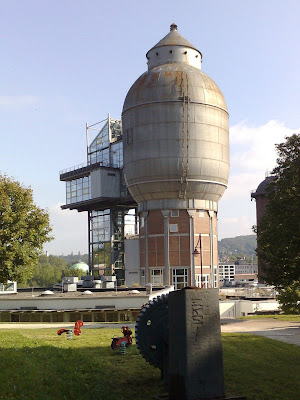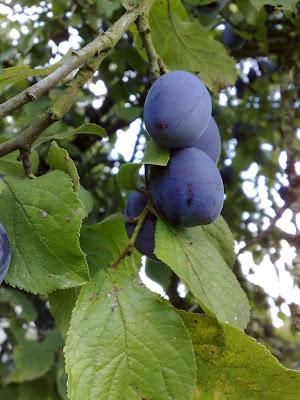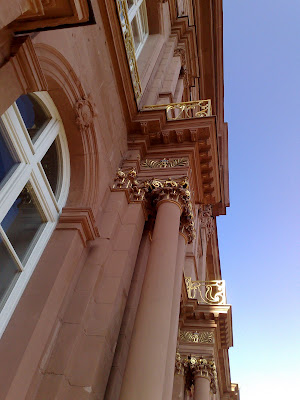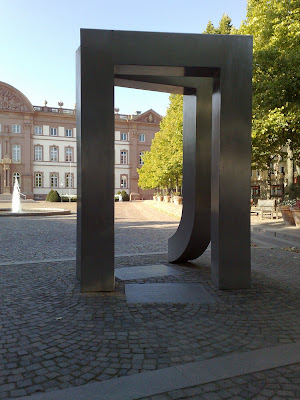2009-09-30
Water tower
Originally built in 1936 to hold cooling water for the steel works, now a restaurant and cinema complex.
The tower has a web page with photos of the interior: http://www.wasserturm-nk.de/wasserturm/.
2009-09-29
Football dummies
These guys were watching the long shadows on the football pitch with me. I think they liked it, too, but they were not saying very much.
2009-09-27
2009-09-26
Wonderball
Incredibly, the ball in the middle of this fountain rotates. There is no way the water has enough force to do this. Either the fountain was designed by Uri Geller, or there is some hidden mechanism causing it to move.
Update: No cheating, no Uri Geller — the 4 ton granite ball rotates by the force of the water alone. The fountain was created by Christian Tobin (Mayer) in 1985.
2009-09-25
Sankt Wendel style
Sankt Wendel may be a minute provincial town, but they seem to be leading the way when it comes to fashion. Accordingly, this is what all trendy men in Germany will be wearing this winter.
2009-09-24
They don't build them like this anymore
In amongst the gleaming new steel and glass around Sankt Wendel railway station lies this old building. It looks rather dilapidated and totally out of fashion. Does it deserve to be offered up to the wrecking ball?
2009-09-22
Optical telegraph in the setting sun
Between 1793 and 1854, a number of telegraph lines were established, radiating from Paris and passing signals via optical means. The stations were 9 to 12 km apart. The one in the photo is a reconstruction. The original on the same spot was intended to form part of the line from Paris to the fortress in Landau via Metz. Construction of the line began in 1793 but was never completed.
2009-09-20
Pumping iron
The barbecue grill briquettes look a bit more modern, but this blacksmith looks like he stepped right out the Celtic village as it was 2,000 years ago.
Although still showing part of the Celtic Weekend, this shot was not taken at the site of the Roman baths in France (2009-09-19), but at the site of a reconstructed Celtic village a 100 metres away in Germany (2009-04-30).
2009-09-19
Let battle commence!
It seems I was not the only one following the traces of the Celts in Lorraine. Several more had turned up to see the activities at the Celtic Weekend at Bliesbruck / Reinheim, which included these Frenchmen demonstrating the battle techniques of their Celtic forefathers. The grandstand in the background is actually the building housing the remains of the Roman baths. Vive Asterix!
2009-09-18
Celtic des. res.
Although Asterix' village held out against the Romans, it did finally fall to modernity. However, rumour has it that in a distant corner of Lorraine, the fighting Gallic spirit lives on. Here I found some traces.
P.S. It has been brought to my attention that there are parts of the world where people have not heard of Asterix. I suggest such people browse through the list of characters on Wikipedia and get a copy of one of the books as soon as possible. Language need not be a barrier. You can even obtain some books in the dialect of the Saarland.
2009-09-17
Ruins on a hill
The Frauenbergeois, the inhabitants of Frauenberg, may only number 567, but they have their own castle ruins.
2009-09-16
The future: renewable energy
They definitely tried to make the most of the River Blies. Five kilometres away from the pottery mill in Sarreguemines is this old hydro-electric power station. In front of it, there is another friendship bridge, a footbridge connecting French Frauenberg with German Habkirchen.
2009-09-14
Pierre was here (and Chantal and ...)
Next to the table with names, there is a footbridge. On the other side of the bridge, I found this pillar, the table's vertical pendant.
2009-09-11
Drama on the Saar
I occasionally feel like a journalist as I go around the city documenting it with photographs. When I took the photo above, I even beat the professionals to the scene.
A tourist boat (not 2009-08-30) began to belch smoke as it was making its way through Güdingen lock. A fire engine soon arrived, its siren clearing the Sunday strollers from the footpath. Soon after, three more fire engines and several police cars turned up to crowd onto the narrow tow path. Above you can see the first, rather ancient, fire engine and the passengers evacuating the boat.
The next day in the paper, I read that the there had been a fire in the engine room, which the captain himself actually put out with a fire extinguisher.
2009-09-09
Building a better Römerkastell
A little digger helping landscape a newly created roundabout — for which the blue rail bridge in the background had to be created.
2009-09-08
What would you say?
Clearly work in progress. A 21st century tram and a group of third century legionnaires are about to have a conversation. I wonder what they have to say to one another.
2009-09-05
Wild west comes to Zweibrücken
Zweibrücken is big on horses. It is home to the state stud farm of Rheinland-Pfalz. On the day I visited, a tribe of country and western fans had set up their tipis there. So much Americana was not a great surprise. The town was a major garrison town for the US army, which at one point had 9,000 American citizens living alongside 38,000 natives and took up 30% of the surface area. When the US army decamped in 1990, the town had to work hard to make good the vast economic vacuum it left in its wake.
2009-09-04
Pigs come to town
These pigs and swineherd are to be found in the Hallplatz in Zweibrücken. They recall the time before 1912 when there was a livestock market on this spot.
2009-09-03
Oblique baroque
The main entrance to the Ducal Palace in Zweibrücken, built between 1720 and 1725 by Jonas Erikson Sundahl in the northern baroque style. It was destroyed in WWII and only restored to its former glory in 1964.
2009-09-02
Light and shade, old and new
A sculpture by Gernot Waldner looking onto the Schlossplatz, the square of the old duke's palace.
What is the sculpture trying to tell us? The official Zweibrücker web site has the answer to that question. In fact, it has two answers. On the German page, we are told the sculpture symbolises the destruction and rebuilding of the town. In the English translation of the same page, we are told the sculpture "represents an open door and invites the viewers to look back into the ducal times".
2009-09-01
's Zweebrigger Luiche
The porter Ludwig Arnold waiting patiently before the Alexanderkirche in Zweibrücken, as immortalised by the sculptor Gerd Dehof,
Subscribe to:
Posts (Atom)





























